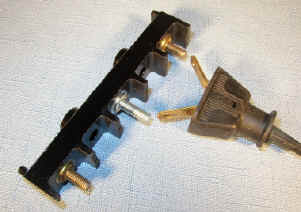|
Testing
for 240 Volts to Your Dryer
- Without a Voltmeter
I always 'preach' testing for the
presence of 240 volts (approx) to your 'no heat' dryer before you take it apart.
Saves a ton of time, as most servicers, including this one, have learned the
hard way.
The frustrating side of that recommendation for
me is that most folks don't have a VOM (volt-ohm-milliammeter) or a 240V
test bulb lying
around the house to test this.
A week or two ago I had one of those little
'Eureka' moments (there aren't nearly as many as there used to be, I
admit!), and I think you'll find this idea useful.
The test involves using a simple table lamp or
other 120V fixture with a two-prong (ungrounded) plug on the end of its
cord. And it works best with one of the lighter plugs with brass blades
that are 'folded over', looking like two pieces sandwiched
together.
To test for 240V at your dryer's terminal block,
where the cord connects, just bend the blades of this plug apart and
touch them to the outer terminals on the block, one pair at a time, like
this:
|

|
|
Note: Test 120V only across terminals as
shown - NOT across 2 outside terminals! |
Your terminal block may look different than this one, but there are 3
terminals on the back of your electric dryer that the cord, or 'pigtail,
connect to. The outer two are 'hots', or 'legs' (Get your minds back on
electricity here, guys <g>), and the one in the middle is the
'neutral'.
When the incoming 240V supply is as
it should be, you'll read 120V on these outer two pairs when measuring to
the center, neutral post. So if your table lamp lights normally when the
plug's touched to the right and center posts, and again when touched to
the left and center posts, you have 120V coming in on both 'legs'.
Important: Be
sure you test 120V only across terminal pairs as shown -
and NOT across the 2 outside terminals (the brass ones in the picture). If
you should do that, the 240V will blow your 120V lamp or whatever you're
using for this test - and very possibly cause you bodily harm! Please be
careful. The 240 volts present across these outside two terminals can kill
you quickly! You have read my disclaimer,
right? I certainly don't want to lose you! <grin>
If 120V is present on both legs, it's
a very, very good bet that you have the 240V you need into the dryer (or
range, or any other 240V single phase appliance). Simple, huh?
Was this article helpful?
Please click the "donate" button on the left side of
this page to help me keep this information free!
Many Thanks! - Dave
Copyright www.DavesRepair.com
This article may be reprinted and distributed freely only
in its entirety, including this message.
|